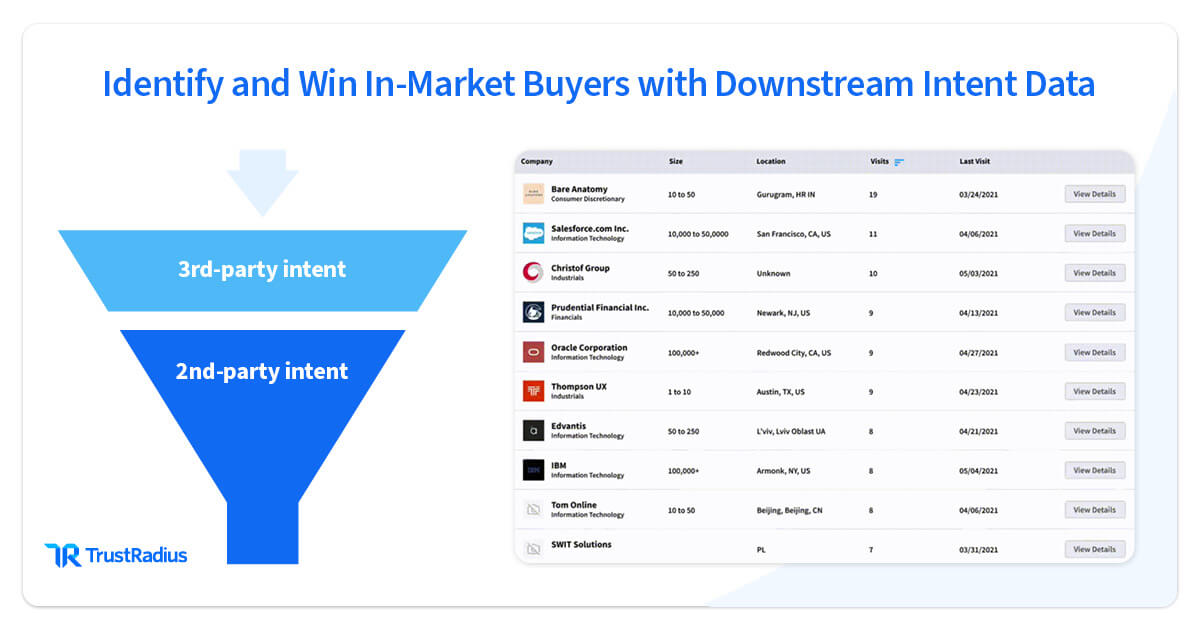Second-Party Downstream Intent Data: What’s the Difference?
Intent data helps brands better understand and reach their audiences, and different types of intent data call for different approaches and drive different results. One relatively new type, second-party intent data, is a company’s first-party data monetized.
Very few companies provide this type of intent data, and most are publishers. However, downstream second-party intent data is a much richer form of second-party intent data that consists of true in-market signals from users consuming high-quality product-related content, such as reading reviews or comparing products and pricing. This type of down-funnel high-fidelity data can only be sourced from review platforms such as TrustRadius.
Second-party intent data is different from top-of-funnel, third-party intent data. Third-party intent data can be valuable for broad campaigns that are generally focused on awareness, but the data is limited to insights from the early phases of the buyer’s journey. First-party intent data, which is derived from your owned properties, can be useful for analyzing the behavior of existing customers or those who are already visiting a brand’s website, but using it well requires appropriate collection, storage, and analysis from the site owner.
Explore what separates downstream intent data from other types and learn more about the three types of second-party downstream intent data available to brands.
What makes downstream intent data unique?
Second- and third-party intent data both come from external sources, so what makes them different? Popular third-party sources are Bombora and ABM platforms like 6sense and Demandbase that have publisher co-ops aggregating search and content consumption to monetize as topic and keyword-search data. These third-party data providers partner with thousands of publishers across the internet using algorithms to model that data, displaying users who are potentially researching information topics related to your business. As mentioned, these signals can be beneficial for awareness campaigns, but as users move further down the buying funnel, their effectiveness can wane.
Second-party intent data was originally introduced as top-of-funnel data directly from publishers that showed buyers reading or searching on their site. This data was accurate but still topical, and did not necessarily represent interest in buying a new product.
Now, there’s a new type of second-party data—downstream intent data—that surfaces buyers actively researching your product or a competitors’. This data can tell you which accounts are looking at your product’s reviews, pricing, and details, or even at your competitors. Brands can determine how active a prospective buyer is within a sales cycle and target them throughout the research phase—before they reach out to vendors.
Because downstream intent data is essentially first-party data made available mostly from review platforms, it contains direct and actionable buyer intent. However, TrustRadius is the only review platform that doesn’t model in other site traffic to its intent data—unlike G2, which models in blog traffic. Our downstream intent data is a true representation of high-fidelity buyers who fit the ideal customer profile.

What distinguishes TrustRadius downstream intent data
TrustRadius has well over 1 million monthly site visitors exploring tech solutions that help solve their problems. While browsing, users begin to research and compare various vendors, and this behavior is converted to signals that help understand where users are in the buying process and predict what they will likely do next.

In fact, TrustRadius refers to this as “downstream intent data” because this buyer is at the very bottom of the funnel. On average, buyers spend around 11 minutes on TrustRadius’ product comparison pages, and our reviews are an average of four times longer than other sites. The content holds users’ attention and keeps them on the site as they continue to consume content—reviewing products and competitors, comparing pricing, and more.
This provides brands with rich buying signals for in-market accounts and context on what they are considering and where they are in the buying process. Brands can then identify and target those buyers when they are closer to making a purchase decision.
It’s also important to note that TrustRadius only includes accounts that are researching a brand’s products, their competitors’ products, or their category, which ensures brands are only reaching relevant, in-market buyers. Some providers, such as G2, include models and blog traffic in their data, diluting true in-market buyers and weakening efforts to convert users.
At TrustRadius, this data is exclusive and not modeled with any other website data, keeping it pure. This is how we know these are in-market buyers closer to a purchase. Additionally, we surface every available account to our customers so you can get a full picture of who is researching you and/or your competitors.
In contrast, G2 customers won’t see accounts researching their competitors’ products if their competitor is also a customer of G2. You will miss out on the ability to get a full view of all in-market buyers for your technology category as there is only a 20% overlap between the audience researching on G2 versus TrustRadius.
3 types of intent data provided by TrustRadius
TrustRadius provides three types of intent data: category-level, product-level, and product comparison. Each level of data provides unique insights into different types of buying behavior. While each level can be used individually, brands need all three levels of data to get a complete set of intent and find all relevant in-market buyers on TrustRadius.
Actionable insights from each type of data help companies create more efficient, effective campaigns. In fact, marketers who use TrustRadius downstream intent data see consistently better campaign performance, including a 30% boost in ad performance and up to an 81% increase in account engagement. In conjunction with marketing campaigns, using downstream intent data for sales prospecting can generate pipeline and increase win rates faster.
Category intent data
Category intent data reveals people at target accounts who are researching products in a technology category, which includes a company’s products and its competitors’. Category-level intent data will cast a wider net, allowing brands to see not only the buyers looking at their product but also the buyers researching their technology category. Brands will also be able to find buyers who are in-market for a solution but aren’t visiting their product pages. TrustRadius is the only intent data provider that gives users full access to category intent data to plan competitive takeout campaigns. When segmenting and targeting these accounts, campaigns should focus on making the audience aware of a product and how it differentiates from others in its category.
Product intent data
Product intent data provides a list of accounts where buyers are exploring products and potentially comparing competitor products. With product-level intent data, brands gain access to all in-market buyers looking at their product, which is a larger pool of buyers than those just comparing products on TrustRadius. These accounts are already aware of a brand’s products and are some of the prospects closest to a decision. Brands should target these audiences with campaigns promoting demo requests, free trials, and other bottom-of-funnel offers to help influence a decision.
Product comparison intent data
6sense and Demandbase customers who have a profile on TrustRadius can access free product comparison intent data. This enables them to see when accounts are comparing their products against their competitors, offering a taste of the impact of downstream intent data.

Downstream intent data offers unique value
Intent data can be as unique as each person browsing a site. While intent data can come from many different sources, quality downstream intent data from a source like TrustRadius depends on the site’s content and the audience. Downstream intent data can provide your brand with direct and actionable buyer intent and enhance your campaigns, especially when complemented by other data.
Check out What is Intent Data? The Ultimate B2B Playbook to learn more and request a demo if you want to see TrustRadius’ downstream intent data in action.






